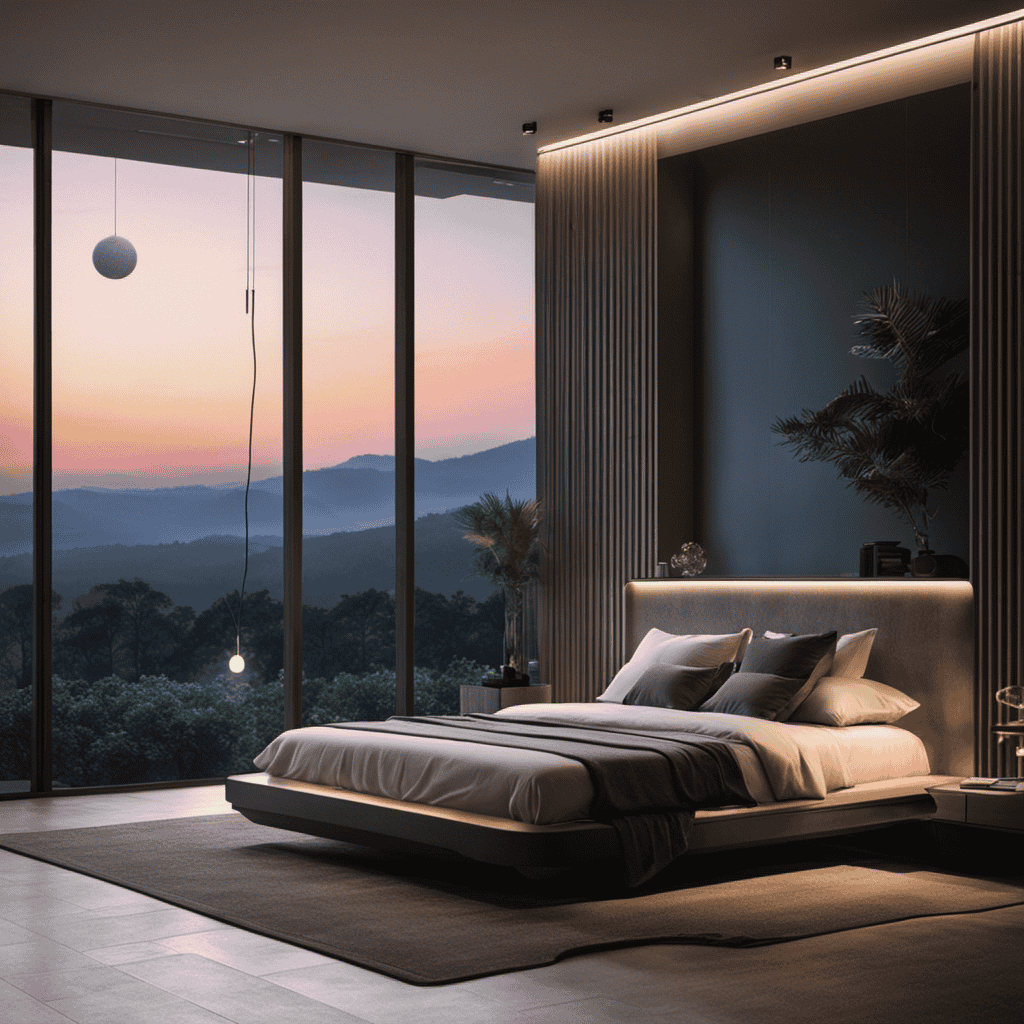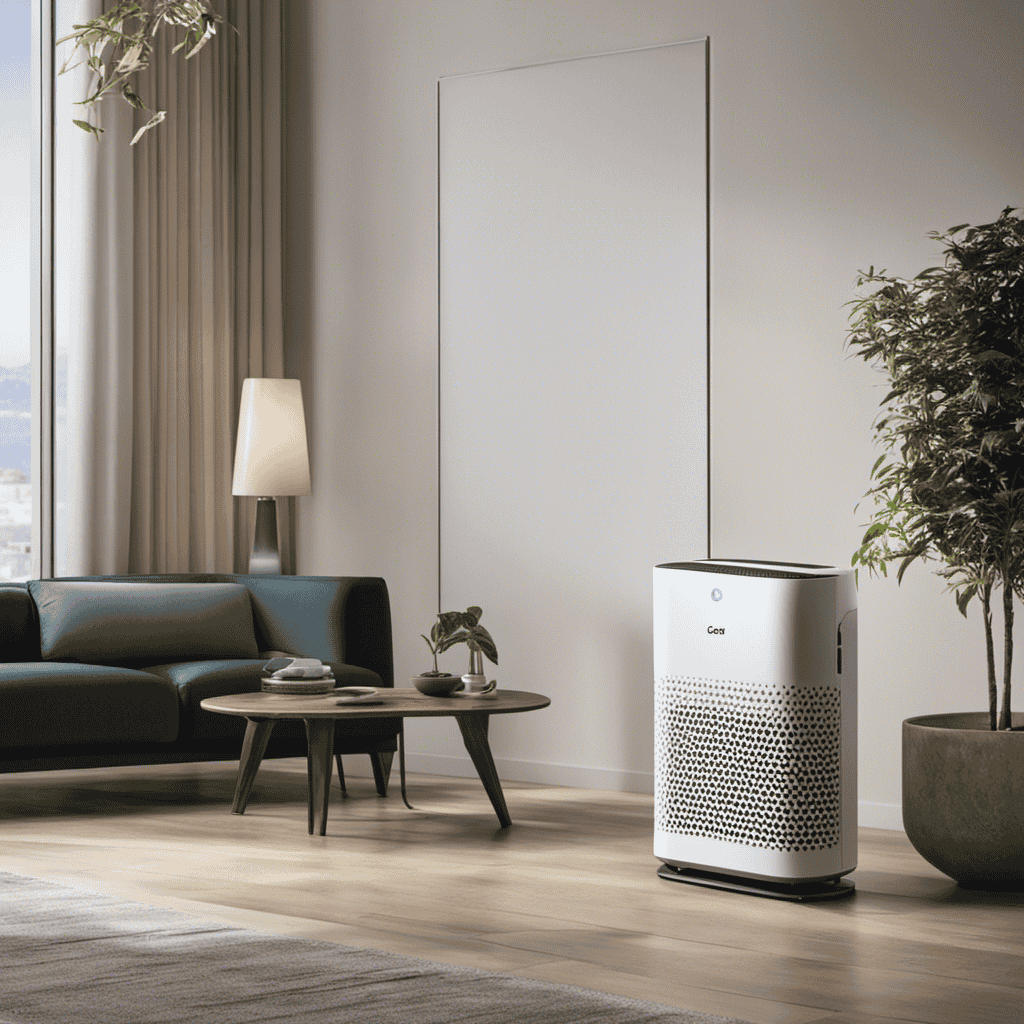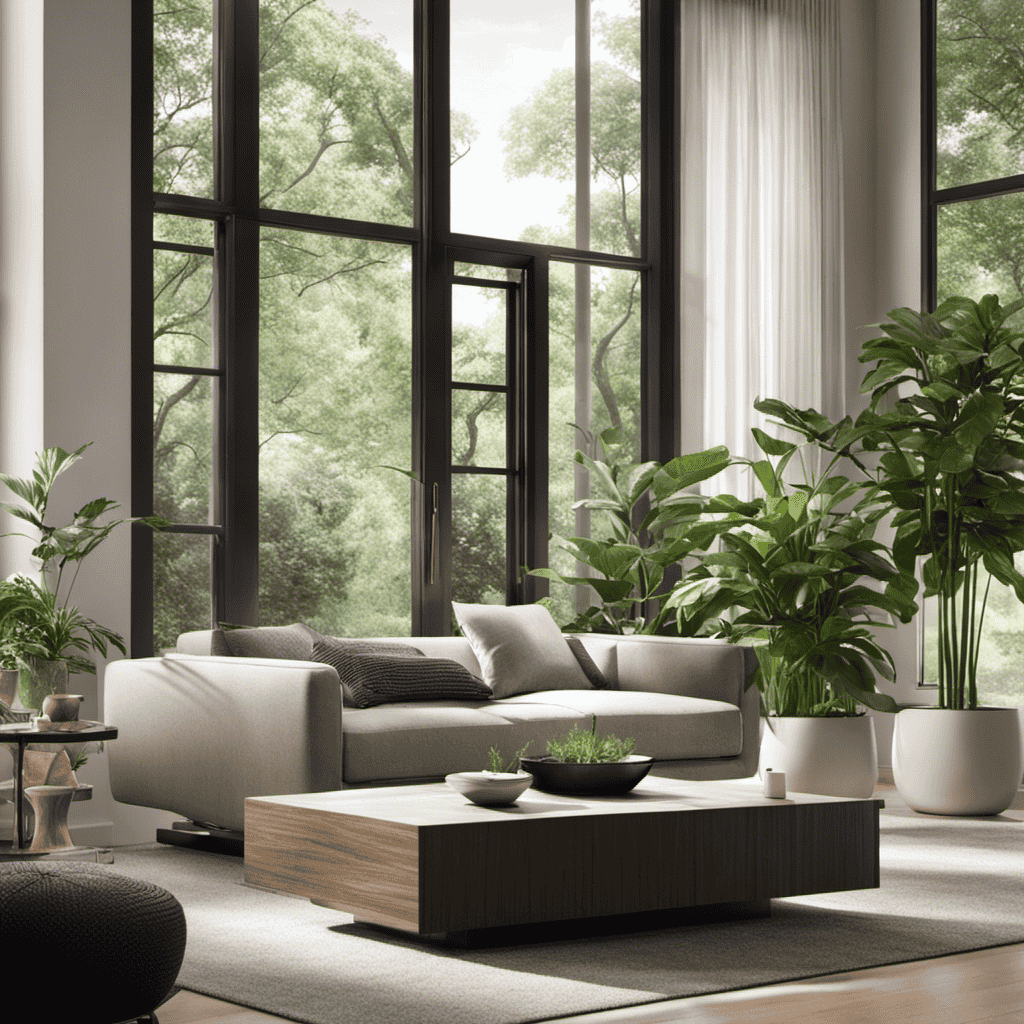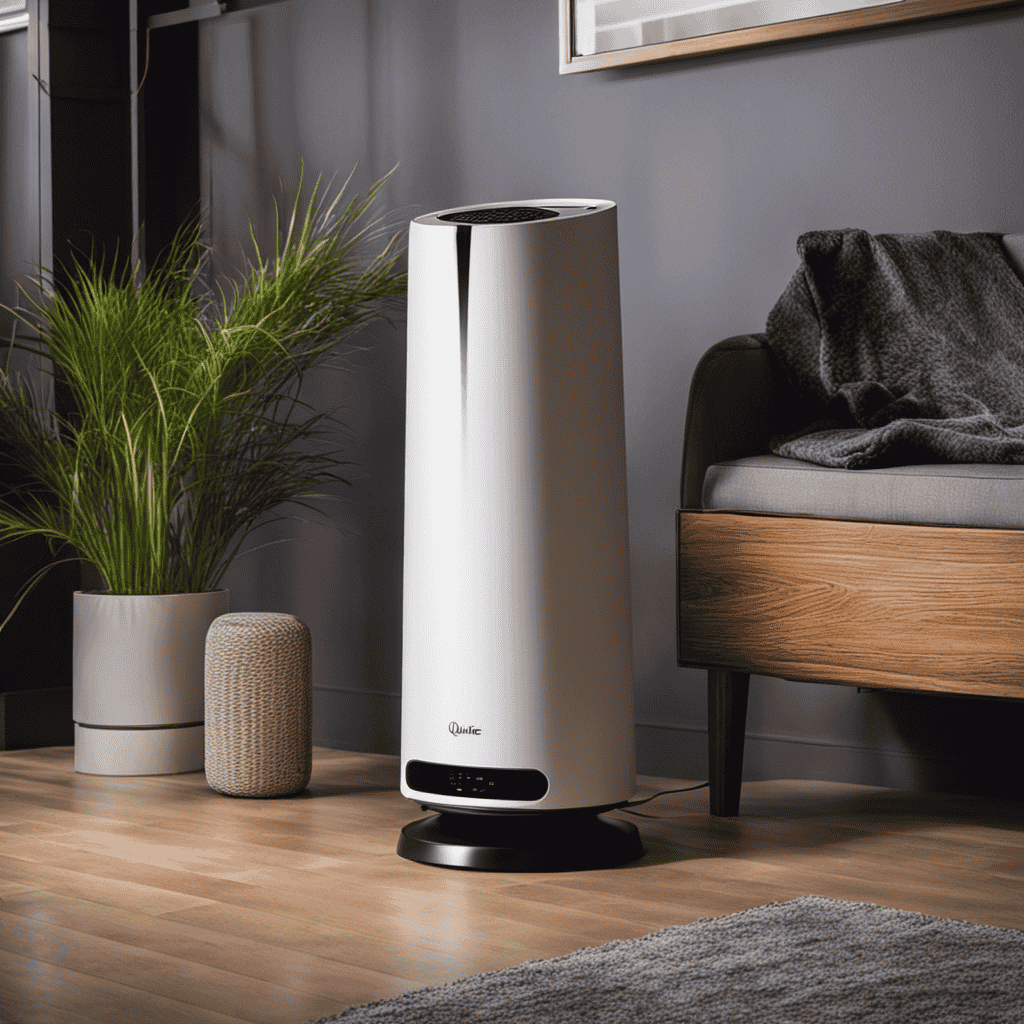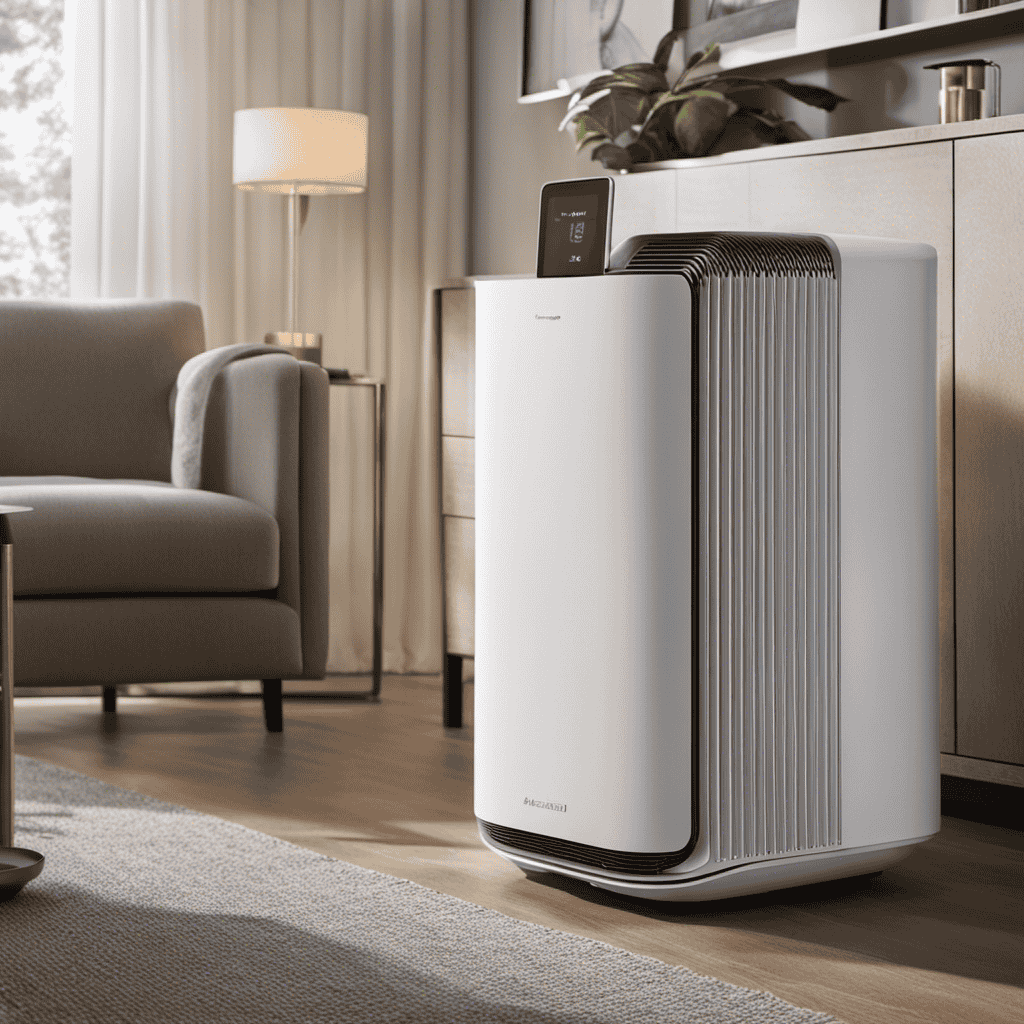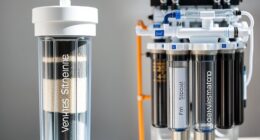As a owner of an air purifier, I frequently question, ‘How long should I leave my air purifier running?’ This is a common inquiry as we all strive to find the optimal balance between fresh air and energy usage.
In this article, we’ll explore the benefits of running your air purifier continuously, factors to consider when deciding how long to keep it on, and the ideal duration for optimal purification.
So, let’s dive in and uncover the secrets to achieving fresh, pure air in our homes.
Key Takeaways
- Running your air purifier continuously can constantly filter air, improve indoor air quality, provide relief for allergies or respiratory conditions, and prevent the build-up of pollutants.
- Factors to consider when deciding how long to keep your air purifier on include the size of the space, level of air pollution, personal preferences, recommended guidelines from the manufacturer, and the impact on electricity consumption.
- Optimal usage duration depends on air quality in your area, the size of the room, recommended guidelines from the manufacturer, and the energy-saving features of the air purifier. It is important to strike a balance between air quality and cost-efficiency.
- Running an air purifier for extended periods increases electricity consumption but also improves air quality. It is recommended to run the purifier for a few hours each day during peak pollution hours or specific triggers and to regularly clean or replace air filters to reduce energy consumption.
Benefits of Running Your Air Purifier Continuously
There’s a lot to gain from keeping your air purifier running continuously. Continuous operation benefits not only your immediate air quality but also has long-term effects on the overall usage of your air purifier.
When your air purifier runs continuously, it ensures that the air in your space is constantly being filtered, removing allergens, pollutants, and odors. This leads to improved indoor air quality and can provide relief for individuals with allergies or respiratory conditions.
Additionally, running your air purifier continuously helps to prevent the build-up of pollutants in your home, reducing the workload on the purifier and extending its lifespan.
Factors to Consider When Deciding How Long to Keep Your Air Purifier on
When it comes to determining the optimal usage duration for your air purifier, several factors need to be considered. These factors include the size of your space, the level of air pollution, and your personal preferences.
Additionally, it’s important to understand the impact that keeping your air purifier on for extended periods can have on your electricity consumption.
Optimal Usage Duration
You should consider keeping your air purifier on for a duration that aligns with the recommended guidelines. Here are some tips to help you determine the optimal usage duration for your air purifier:
-
Consider the air quality in your area. If you live in a highly polluted area, it may be necessary to keep your air purifier on for longer periods of time.
-
Take into account the size of the room. Larger rooms may require a longer duration of air purification to effectively clean the air.
-
Check the recommended guidelines provided by the manufacturer of your air purifier. Different brands may have different recommendations for optimal usage duration.
-
Consider energy-saving features. Some air purifiers have built-in sensors that automatically adjust the fan speed based on the air quality, allowing you to save energy while still maintaining clean air.
Impact on Electricity Consumption
The impact of running an air purifier for extended periods of time can be seen in increased electricity consumption. When an air purifier is continuously running, it filters the air more frequently, resulting in improved air quality. However, this comes at the cost of higher energy usage and increased electricity bills.
It is important to strike a balance between maintaining good air quality and being cost-efficient. To achieve this, it is recommended to run the air purifier for a few hours each day, especially during peak pollution hours or when there are specific triggers like pet dander or allergies.
Regularly cleaning or replacing the air filters can also help improve air quality and reduce the energy consumption of the air purifier.
Ideal Duration for Running an Air Purifier
When it comes to running an air purifier, there are several key points to consider.
First, you want to determine the optimal runtime for your purifier to ensure maximum air quality improvement.
Second, it is important to be mindful of energy consumption and find a balance between air purification and energy efficiency.
Lastly, understanding how your purifier works and its capabilities will help you make informed decisions about running it for the right duration to achieve the best results.
Optimal Purifier Runtime
To maximize the effectiveness of your air purifier, it’s helpful to determine the optimal runtime. Finding the ideal duration for running your air purifier can have a significant impact on air quality improvement in your home. Here are four factors to consider when determining the optimal runtime:
-
Room Size: Larger rooms may require longer runtime to effectively clean the air, while smaller rooms may need less time.
-
Air Quality: If your indoor air quality is poor, running the air purifier for longer periods can help remove pollutants and allergens more effectively.
-
Allergies or Asthma: If you or your family members suffer from allergies or asthma, running the air purifier for longer can provide continuous relief by trapping and eliminating airborne allergens.
-
Seasonal Changes: Consider adjusting the runtime based on the season. During peak allergy seasons or when pollution levels are high, running the air purifier for longer can provide better air quality.
Air Quality Improvement
Running your air purifier for longer periods can effectively remove pollutants and allergens, improving the quality of the air in your home.
By keeping your air purifier on for extended periods, you allow it to continuously filter the air, ensuring that any harmful particles are continuously removed. This not only improves air circulation but also helps to reduce the presence of allergens and pollutants in your home, creating a healthier living environment.
However, it is important to remember that regular air purifier maintenance is crucial to ensure optimal performance. This includes cleaning or replacing the filters as recommended by the manufacturer.
Additionally, periodic maintenance checks and cleaning of the unit itself can help prevent the buildup of dust and debris, ensuring that your air purifier continues to effectively improve the air quality in your home.
Energy Consumption Considerations
By reducing the time your air purifier is operational, you can lower energy consumption while still maintaining satisfactory air quality. Here are some energy saving tips to help you use your air purifier in a cost-effective way:
-
Determine the optimal time: Assess the air quality in your home and identify when it is most necessary to use the purifier. This will help you avoid running it unnecessarily.
-
Use a timer: Set a timer on your air purifier to ensure it runs only when needed. This will prevent it from running continuously and consuming excess energy.
-
Clean or replace filters regularly: Dirty filters can reduce the efficiency of your air purifier, causing it to work harder and consume more energy. Clean or replace filters as recommended by the manufacturer.
-
Maintain proper ventilation: Ensure that your home is properly ventilated to allow fresh air to circulate. This will reduce the reliance on your air purifier and lower energy consumption.
How Often Should You Run Your Air Purifier
You should typically run your air purifier for about 8-12 hours a day to maintain clean air in your home. This duration ensures maximum efficiency and effectiveness of your air purifier in removing pollutants and allergens from the air.
Running the air purifier for this recommended time frame helps to maintain good indoor air quality and reduce the risk of respiratory issues caused by poor air.
However, it is important to note that the duration may vary depending on factors such as the size of your home and the air quality in your area.
It is also crucial to regularly clean and maintain your air purifier to ensure its optimal performance. This includes changing filters as recommended by the manufacturer and cleaning the unit regularly to prevent dust and dirt buildup.
Proper air purifier maintenance will prolong its lifespan and help it work efficiently for a longer period of time.
The Importance of Proper Air Circulation With Your Air Purifier
To ensure effective air purification, it’s important to make sure that your home has proper air circulation in conjunction with your air purifier. Here are four reasons why proper air circulation is crucial for the maintenance and optimal functioning of your air purifier:
-
Reduced allergens: Proper air circulation helps your air purifier to effectively capture and filter allergens such as pollen, dust mites, and pet dander, reducing the risk of allergies.
-
Improved air quality: Good air circulation allows the purified air to circulate throughout your home, ensuring that every room receives clean and fresh air.
-
Prevention of stale air: Proper air circulation prevents the buildup of stale air, which can lead to unpleasant odors and mold growth.
-
Enhanced efficiency: With proper air circulation, your air purifier can operate more efficiently, prolonging its lifespan and reducing the need for frequent maintenance.
Understanding the importance of air circulation in conjunction with your air purifier is crucial for maintaining clean and healthy indoor air quality. Now let’s delve into understanding the air quality in your home and its impact on air purifier usage.
Understanding the Air Quality in Your Home and Its Impact on Air Purifier Usage
Understanding the air quality in your home and how it affects air purifier usage can help you optimize the performance of your device.
Indoor air quality monitoring is crucial in identifying and addressing air pollution sources. By understanding the sources of air pollution, such as pet dander, dust mites, and volatile organic compounds (VOCs), you can make informed decisions about when to use your air purifier.
For example, if you have a pet that sheds a lot, you may want to run your air purifier more frequently to remove pet dander from the air. Similarly, if you live in an area with high levels of outdoor pollution, you may want to keep your air purifier running continuously to filter out any pollutants that enter your home.
Monitoring the air quality in your home and adjusting your air purifier usage accordingly can help ensure that you are breathing clean, healthy air.
How to Determine the Right Settings for Your Air Purifier
Once you’ve determined the right settings for your air purifier, it will effectively filter out pollutants and improve the air quality in your home. Here are some steps to help you determine the effectiveness and set your preferences:
-
Assess your indoor air quality: Use an air quality monitor to measure the levels of pollutants such as dust, pollen, and pet dander in your home.
-
Consider your specific needs: If you have allergies or respiratory issues, you may need to set your air purifier to a higher fan speed or use specific filters to target allergens.
-
Adjust the settings based on room size: Larger rooms may require a higher fan speed or longer operating time to effectively clean the air.
-
Experiment and monitor the results: Try different settings and observe how your air purifier performs. Keep an eye on any improvements in air quality and adjust as needed.
Tips for Maximizing the Effectiveness of Your Air Purifier
If you want to maximize the effectiveness of your air purifier, try placing it in a central location in the room. By doing so, you ensure that the purifier can circulate the air more efficiently, reaching all corners of the room.
Additionally, make sure to regularly maintain your air purifier to keep it functioning at its best. This includes cleaning or replacing the filters according to the manufacturer’s instructions. Neglecting maintenance can reduce the purifier’s effectiveness and potentially harm the air quality in your space.
Furthermore, consider the size of the room when choosing an air purifier. A purifier that is too small for the room will struggle to effectively clean the air, while one that is too large may be unnecessary and waste energy.
Proper placement and maintenance are key to getting the most out of your air purifier.
The Role of Air Purifiers in Allergy and Asthma Management
Placing an air purifier in a central location can help manage allergies and asthma symptoms. Air purifiers work by filtering out allergens and pollutants from the air, creating a cleaner and healthier environment. Here are four reasons why air purifiers are essential for allergy and asthma management:
- Air purifiers remove airborne allergens such as pollen, dust mites, and pet dander, reducing exposure and minimizing symptoms.
- They trap and remove harmful particles, such as smoke and mold spores, improving indoor air quality and respiratory health.
- Air purifier filters capture bacteria and viruses, preventing the spread of illnesses and reducing the risk of respiratory infections.
- Investing in an air purifier is cost-effective in the long run, as it reduces the need for medications and doctor visits.
By incorporating an air purifier into your home, you can effectively manage allergies and asthma symptoms.
Now, let’s explore how the size of your room affects air purifier usage.
Does the Size of Your Room Affect Air Purifier Usage
When it comes to using an air purifier, the size of your room can have a significant impact on its effectiveness. The size of the room determines how well the air purifier can circulate and filter the air.
A larger room may require a higher-capacity air purifier or multiple units to achieve the desired level of air purification.
Room Size and Usage
To determine how long you should keep your air purifier on, consider the size of the room and how frequently it is used. The size of the room plays a crucial role in determining the effectiveness of your air purifier. Here are some factors to consider:
-
Room Size: Larger rooms may require longer usage time to ensure optimal air purification. A smaller room, on the other hand, may need a shorter duration.
-
Airflow: If the room has poor airflow or is poorly ventilated, it may be necessary to keep the air purifier running for a longer period.
-
Pollution Level: If the room is exposed to high levels of pollutants, such as smoke or allergens, it may be necessary to keep the air purifier on for extended periods.
-
Noise Level: Consider the noise level of the air purifier. If it is too loud, you may prefer to run it only when you are not using the room.
Impact of Room Size?
When it comes to the impact of room size on air purifiers, it’s important to consider the effectiveness in larger rooms. Larger rooms typically have more air to circulate and thus require a more powerful air purifier to effectively remove allergens and pollutants.
A smaller air purifier may struggle to clean the air in a larger space, resulting in reduced effectiveness. Additionally, larger rooms may have more sources of allergens, such as pet dander or dust, which can make it more challenging for an air purifier to keep the air clean.
Therefore, when choosing an air purifier for a larger room, it’s crucial to select a model that is specifically designed for larger spaces and has a higher CADR (Clean Air Delivery Rate) to ensure optimal performance and maximum impact on allergies.
Energy-Saving Strategies for Running Your Air Purifier
If you want to save energy while running your air purifier, you can try using it on a lower fan speed setting. This not only helps in maximizing efficiency but also reduces energy consumption.
Here are some energy-saving strategies that you can implement:
-
Adjust the fan speed: Most air purifiers have multiple fan speed settings. Lowering the fan speed reduces the energy used while still effectively cleaning the air.
-
Use a timer: Set your air purifier to run for a specific amount of time. This way, it will only operate when needed, saving energy when the air quality is already clean.
-
Clean and replace filters regularly: Dirty filters restrict airflow, making the air purifier work harder and consume more energy. Keep the filters clean and replace them as recommended by the manufacturer.
-
Position strategically: Place your air purifier in a central location to optimize air circulation and minimize the need for higher fan speeds.
Nighttime Usage: Should You Keep Your Air Purifier on While You Sleep
Running the air purifier while I sleep can help improve the air quality in my bedroom. However, it’s important to consider the noise levels and the impact on sleep quality.
Air purifiers vary in terms of noise levels, with some models being quieter than others. It’s crucial to choose a model that operates quietly, especially if you’re a light sleeper. Excessive noise can disrupt sleep and lead to decreased sleep quality.
Additionally, some air purifiers come with a sleep mode feature that reduces noise levels during nighttime operation. This can be beneficial for those who are sensitive to noise while sleeping.
Overall, finding the right balance between air purification and sleep quality is essential for a good night’s rest.
How Long Should You Run Your Air Purifier During the Day
To maximize the effectiveness of your air purifier during the day, it’s recommended to run it for several hours in the areas of your home with the most traffic and potential contaminants. Here’s why this is the optimal running time and the health benefits it can provide:
-
Improved Indoor Air Quality: Running your air purifier for several hours during the day helps to continuously filter out pollutants, allergens, and other harmful particles from the air. This ensures that you and your family breathe cleaner and healthier air.
-
Reduced Allergy Symptoms: By constantly purifying the air, your air purifier can help reduce allergy symptoms such as sneezing, coughing, and itchy eyes. This provides relief for those with allergies or asthma.
-
Elimination of Odors: Running your air purifier for an extended period during the day can help eliminate unpleasant odors from cooking, pets, or other sources. This leaves your home smelling fresh and clean.
-
Enhanced Overall Well-being: Breathing cleaner air can have a positive impact on your overall well-being. It promotes better sleep, improved concentration, and reduced respiratory issues.
The Benefits of Using a Timer or Scheduling Feature on Your Air Purifier
When it comes to air purifiers, finding the optimal purification time is crucial for maintaining clean and healthy indoor air.
By using the timer or scheduling feature on your air purifier, you can customize the purification time to suit your specific needs and preferences.
Not only does this energy-saving option help to reduce electricity usage and lower your bills, but it also ensures consistent indoor air quality throughout the day.
Optimal Purification Time
You should consider the optimal purification time for your air purifier. Finding the right balance between filter lifespan and noise level impact is crucial for getting the most out of your device.
Here are four key factors to consider:
-
Room size: The larger the room, the longer you may need to run the air purifier to achieve optimal purification.
-
Air quality: If you live in an area with high pollution or allergens, longer purification times may be necessary.
-
Noise level: Some air purifiers can be quite noisy, so it’s important to find a balance between purification time and noise level impact.
-
Filter lifespan: The longer you run your air purifier, the faster the filters will get clogged. It’s crucial to follow manufacturer guidelines and replace filters at the optimal time to ensure maximum efficiency.
Energy-Saving Scheduling Options
Consider utilizing energy-saving scheduling options for your air purifier.
Many modern air purifiers come with energy-saving features and programming options that allow you to optimize their usage while minimizing energy consumption. These features enable you to set specific time intervals for the air purifier to operate, ensuring that it runs only when needed.
By programming your air purifier to turn on and off at strategic times throughout the day, you can effectively clean the air in your space while conserving energy.
Additionally, some air purifiers have sensors that detect the air quality and adjust their operation accordingly. This ensures that the purifier is working efficiently and only running when necessary.
Take advantage of these energy-saving features and programming options to maximize the effectiveness of your air purifier while reducing energy costs.
Consistent Indoor Air Quality
Using an air purifier with consistent operation ensures that the quality of indoor air remains high. Maintaining your air purifier and understanding its lifespan are crucial for optimal performance. Here are some key points to consider:
-
Regular Cleaning: Clean the air filters at least once every three months to remove dust, allergens, and pollutants. This helps the purifier function efficiently.
-
Replacement Filters: Replace the filters as recommended by the manufacturer. Over time, filters become less effective in capturing particles, so timely replacement ensures better air quality.
-
Proper Placement: Position the air purifier in a central location to maximize its coverage. Avoid placing it near walls or furniture that can obstruct airflow.
-
Routine Maintenance: Follow the manufacturer’s guidelines for overall maintenance, including checking for any signs of damage, changing UV bulbs if applicable, and keeping the unit clean.
Assessing Air Purifier Usage Based on External Factors (Pollution Levels, Pet Dander, Etc.)
To determine how long to keep your air purifier on, take into account external factors such as pollution levels and pet dander. Assessing air purifier effectiveness is crucial in maintaining good indoor air quality.
The runtime of your air purifier depends on the specific conditions in your environment. If you live in an area with high pollution levels or have pets that shed a lot of dander, you may need to run your air purifier for longer periods.
Regularly check the air quality in your home using a reliable air quality monitor. This will help you determine the effectiveness of your air purifier and whether it needs to be run more or less frequently.
Frequently Asked Questions
Can I Leave My Air Purifier on All Day and Night?
I can leave my air purifier on all day and night, but it’s important to consider the impact on energy consumption. Running it continuously may increase electricity usage. Additionally, the lifespan of the filters may be affected.
Is It Safe to Leave My Air Purifier Running When I’m Not at Home?
It is safe to leave your air purifier running when you’re not at home. Running it while you’re at work provides benefits, such as continuous purification. However, consider the impact on your energy bill.
Should I Run My Air Purifier in Every Room of My House?
Running an air purifier in every room of the house depends on the air purifier’s effectiveness and energy consumption. It’s important to consider if air purifiers work equally well in every room and how much electricity they use.
Can I Turn off My Air Purifier During the Day and Only Run It at Night?
During the day, I can turn off my air purifier to save energy. Running it only at night ensures clean air while minimizing daytime usage. It’s a practical approach to balancing effectiveness and energy consumption.
Is It Necessary to Adjust the Settings on My Air Purifier Based on the Time of Day or External Factors?
It is not necessary to adjust the settings on my air purifier based on the time of day or external factors. Running it throughout the day ensures constant purification and effectiveness in removing pollutants.
Conclusion
In conclusion, determining the optimal duration for running your air purifier depends on various factors such as the air quality, your specific needs, and external factors like pollution levels or pet dander.
Consider using a timer or scheduling feature to automate the process and ensure consistent clean air. Just as a gardener tends to their plants to promote growth and vitality, keeping your air purifier on for the right amount of time nourishes your indoor environment, fostering a healthier and more refreshing atmosphere.
